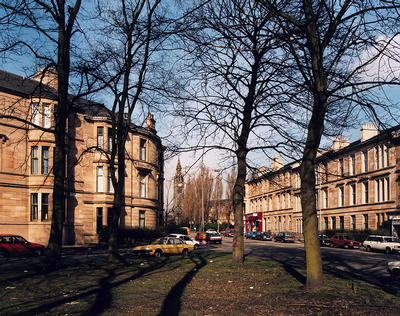
Glasgow's traditional honey-coloured sandstone tenements bask in the early spring sunshine in Pollokshields, c 1990. The photograph was taken at the junction of Barcaldine Terrace (formerly Douglas Terrace), left, and Nithsdale Road, right, looking west towards the tower of Pollokshields West Church in the distance.
Most of the eastern area of Pollokshields was developed between 1855 and 1910 in a grid street pattern, as an upmarket area of tenement flats. The sandstone was obtained from the Giffnock quarries for the earlier developments and from Ballochmyle and Locharbriggs for the others. The later tenements, mainly south and west of Nithsdale Road, are considered to be some of the finest in Scotland. Trees, gardens and open spaces fostered an impression of restrained prosperity in an area which has survived largely unchanged since its completion.
Pollokshields was designated a conservation area in 1973. Two separate areas were designated, east and west, with Shields Road and Terregles Avenue the dividing line. Since then, stone cleaning and other restoration projects have enhanced the appearance of the area.
Reference: Bulletin photographs, Box 3, Private Housing
Reproduced with the permission of Glasgow City Council, Libraries Information and Learning
Keywords:
apartments, churches, conservation areas, flats, gardens, Pollokshields West Church, sandstone, stone cleaning, tenements, trees, urban regeneration
You have 0 images in your photo album.